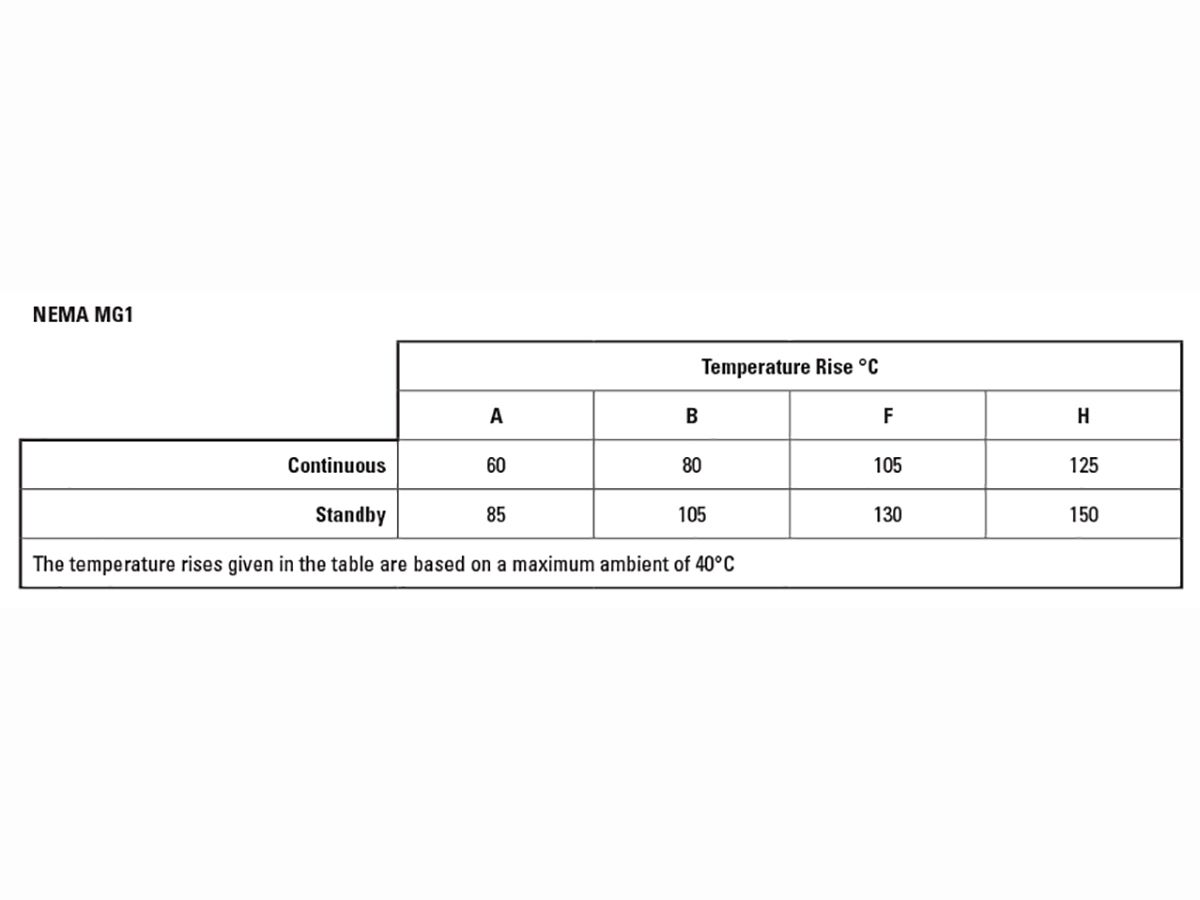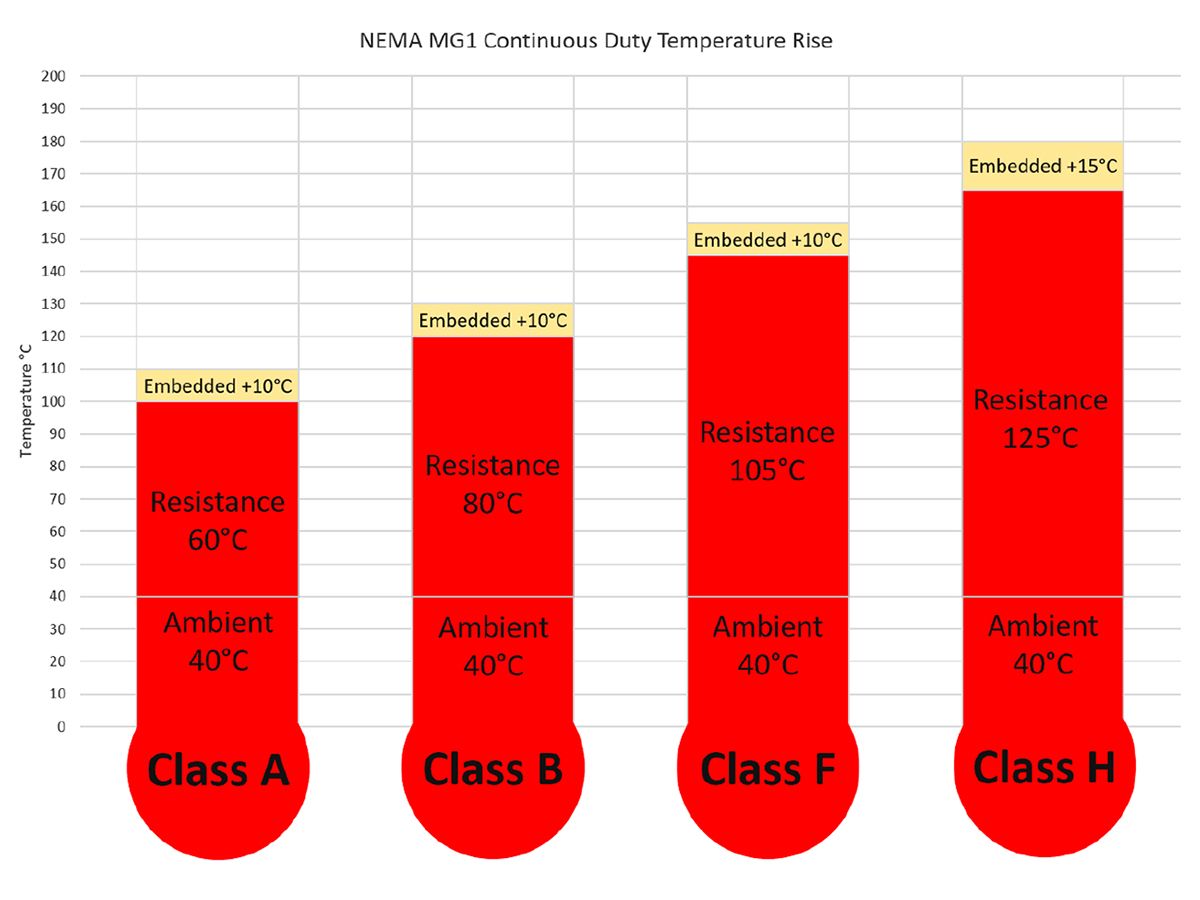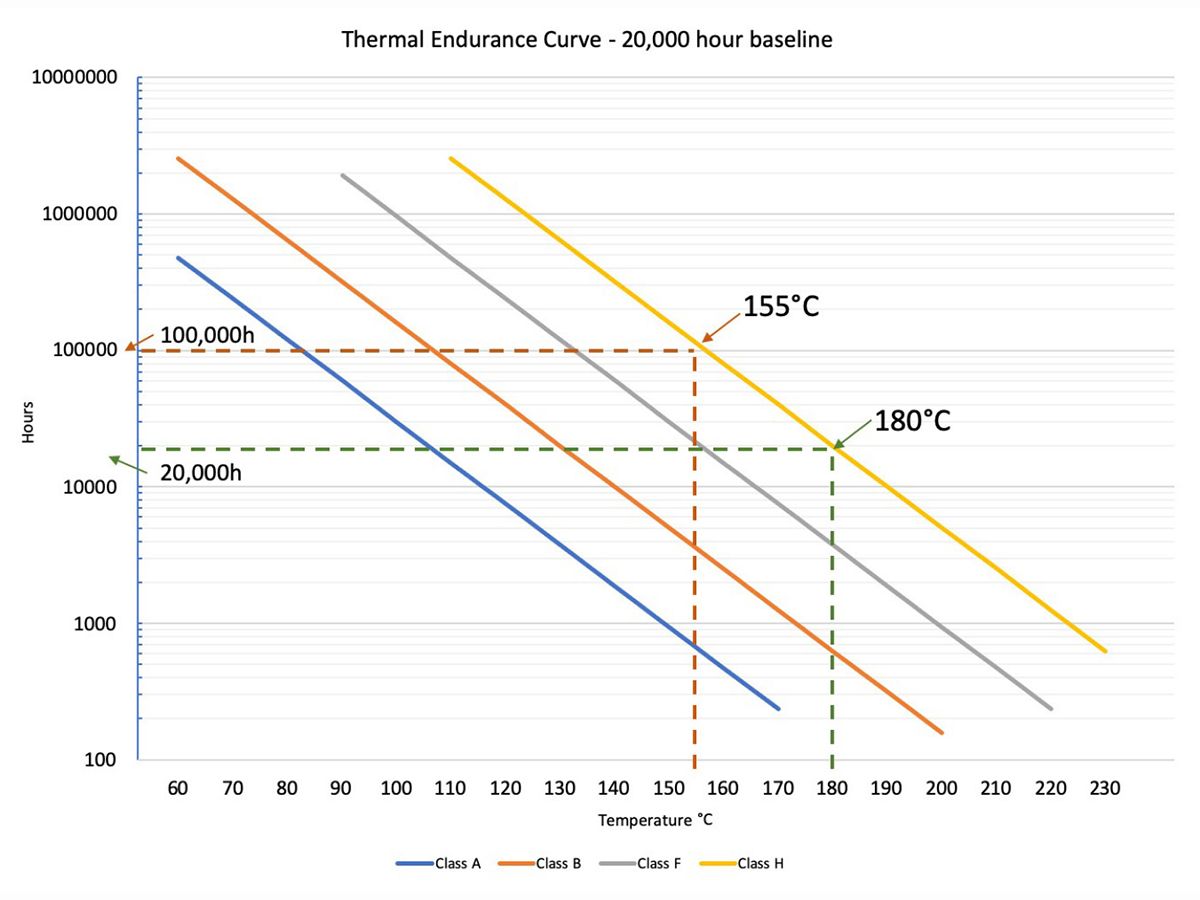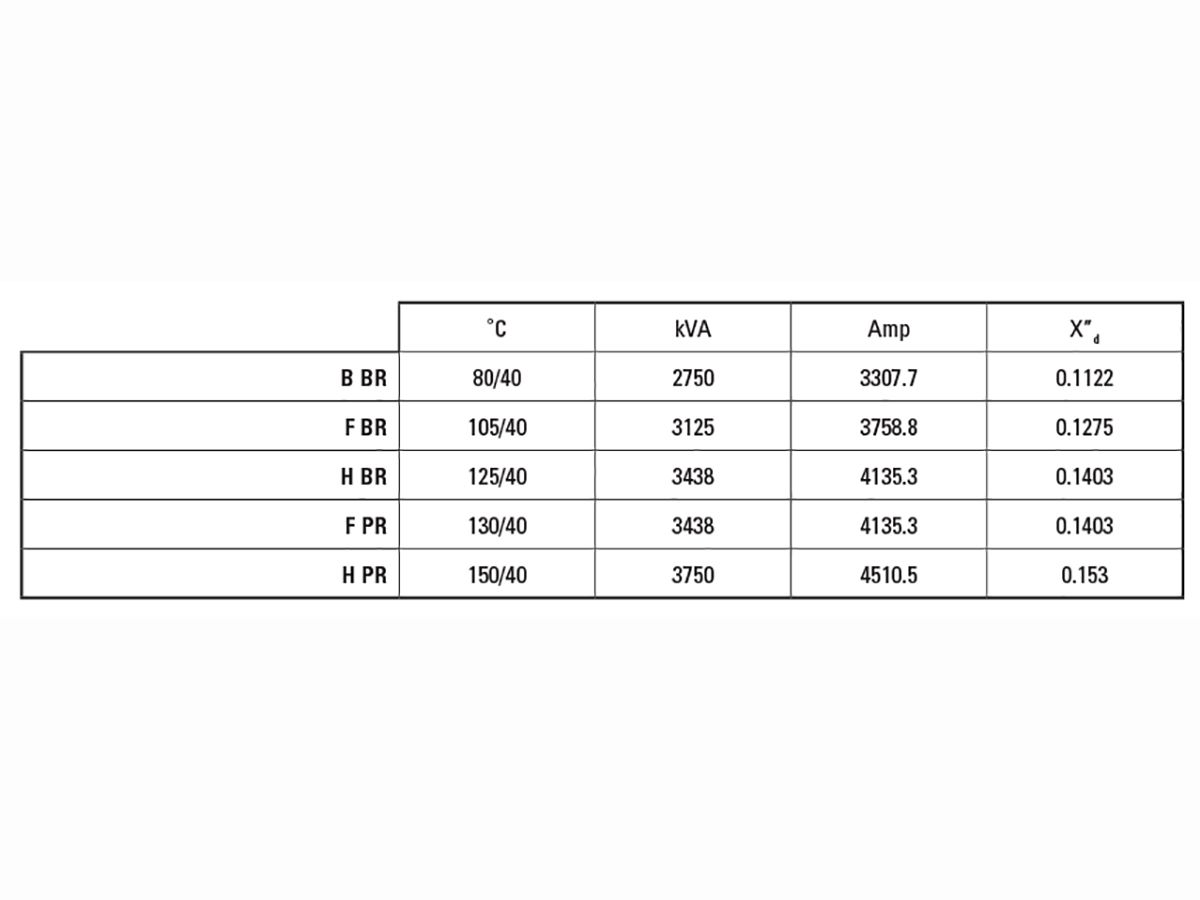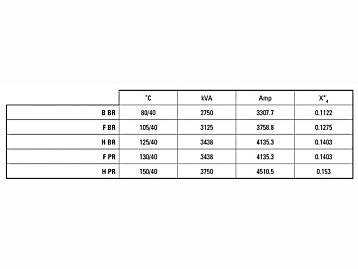THERMAL ENDURANCE
So, what is “suitable thermal endurance”? Thermal endurance is not specifically indicating at what point an insulation system will fail, but more indicating when the thermal breakdown of the material could be expected. There are numerous stresses placed on an insulation system within a generator from Electrical, Thermal, Mechanical and Environmental factors. All of these factors work both independently and together to degrade the overall life of the insulation system and may eventually lead to a failure. The thermal endurance of the system uses accelerated life testing along with real world historical analysis to rate the materials used within the insulation. The materials are typically expected to meet a baseline of 20,000 hours of continuous operation before degradation. From this baseline a Thermal Endurance Curve can be developed using the Arrhenius equation, also known as the Rule of 10. This rule states that for every 10°C decrease in temperature, the insulation life will double. The Thermal Endurance Curve in Figure 2 demonstrates the endurance related to each of the four insulation classes.
As highlighted by the dashed lines in Figure 2, the curve demonstrates the thermal endurance of a generator with a Class H insulation operating at 180°C (40°C Ambient + 125°C Rise + 15°C Thermal Margin) is 20,000 hours. The same generator with Class H insulation operating at 155°C (40°C Ambient + 105°C Rise + 10°C Thermal Margin) should be expected to have a thermal endurance in excess 100,000 hours. Comparatively, if a generator with a Class F insulation were to operate at 155°C it would be expected to have a thermal endurance of 20,000 hours. Understanding the Thermal Endurance curves help when evaluating generators of different insulation classifications.
SPECIFYING INSULATION CLASS
Often a customer specification for a generator will state both an insulation classification as well as a temperature rise for the generator. It should be recognized that the temperature rise should be proportionally aligned with the insulation class. That is to say, when a specification requests a Class F Insulation with a 105°C temperature rise over a 40°C ambient per the NEMA MG-1 standard, an acceptable alternative offering would be to provide a Class H insulated generator at a 125°C temperature rise over a 40°C ambient. This is possible because the generator will provide the same thermal endurance. If the 105°C rise is used with the Class H insulation the customer will be paying for 100,000 hours when they are expecting 20,000 hours. Additionally, considerations should be made when specifying for a standby or continuous operation application, to align with the allowances within the standards. When using the NEMA temperature rise of 180°C (40°C + 125°C + 15°C) for Class H continuous operation, as shown in Table 1, the expected endurance would be 20,000 hours as shown previously on Figure 2. If the application is expected to be a standby application an allowance of an additional 25°C should be provided within the specification. The additional 25°C would provide a total temperature of 205°C (40°C + 150°C + 15°C) for a Class H standby operation. As shown on Figure 3, the expected thermal endurance for the standby application would be 4,000 hours. In a standby application, which is typically expected to operate less than 200 hours a year, this would be a difference of 100 years to 20 years of operation. While the thermal endurance is not an absolute with regards to the life of the generator, it does indicate an increased robustness of the overall generator design, which could drive additional cost where the value is not recognized.
SPECIFYING TEMPERATURE RISE
Temperature Rise is not always used in customer specifications exclusively to indicate the thermal endurance of the generator. Often a specification will use a lower temperature rise with the assumption this will provide a more robust generator with regards to performance. This assumption will work in most cases but could be a costly means to achieve the desired results. As stated previously, when electrical current flows through a wire, heat is generated. The resistance of the wire and the amount of current being passed, in part, determine how much the temperature of the wire will rise. Further, the transfer of heat to the materials around the wire along with their ability to dissipate the heat will determine the overall temperature rise of the alternator. Generator manufacturers use the different temperature rises to classify the ratings of the generator based on the flow of current. The same generator may be used at multiple different temperature rises to achieve different ratings as indicated by the data from a single generator in Figure 2. This same generator may be used in applications from 3750 kVA Standby to 2750 kVA Continuous.
Notably by altering the rating of the generator, which lowers the amperage supported, the Subtransient Reactance (X”d) of the generator is also lowered, because it is a ratio related to the rated current. Subtransient Reactance is also used to indicate the electrical robustness of the generator. A lower Subtransient Reactance will provide more available current during the initial demand enabling the generator to respond faster to changes in load. This is often referred to as being a “stiffer source”.
The lower Subtransient Reactance is made possible with the lower temperature rise because more copper is available to provide current than is typically being used. This additional copper is available during the initial demand for energy and makes the generator more responsive. Another way to increase the amount of copper available within a generator is by changing the winding methods. By changing a generator from a Random Wound to a Form Wound generator, as shown in Figure 5, you increase the available copper without impact to the temperature rise rating. This reduces the Subtransient Reactance, providing better performance.
While changing from Random Wound to Form Wound may increase the cost of the generator, it is possible that the increased cost will be less than increasing a temperature class which could require a larger overall generator. There are also methods to improve the generators performance which may actually lower the cost of the generator. The Table below shows two generators with the same temperature rating. Both are Form Wound generators with the same frame sized stator.
The difference between these generators is in the design of the rotor. The changes within the design of the rotor enable Generator B to provide 2% better Subtransient Reactance, but the real value is in Generator B being nearly 20% less cost than Generator A. Due to the changes, Generator B does have less Leading Power Factor capability than Generator A, however this may be acceptable for many applications and provides a significant cost advantage.
SUMMARY
The insulation class and temperature rise of a generator are critical factors that directly influence generator designs and should be considered when drafting requirements specifications. The insulation classification of the generator will determine the materials used to insulate the generator and when combined with the temperature rise targets will provide an expected thermal endurance of the generator. A customer can use this information to generally predict the scale of expected life related to thermal wear and develop an equivalent baseline between products from different manufacturers.
Temperature rise is also often used in specification to identify the robustness of a generator with relation to performance, however this can be a costly method for delivering improved performance. When specifying for performance it would be better recommended to use factors directly related to the performance being sought. For example, if generator response is desirable using factors such as motor starting, or Subtransient Reactance values would allow the generator manufacturer to provide products which meet the desired effect with a potential for less impact on cost.


